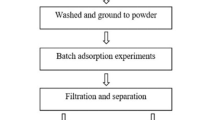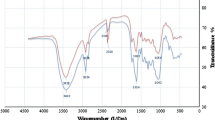Abstract
Among the low-cost adsorbent are agricultural residues, which can be used in natura or modified forms. This work evaluated the adsorption of Ni2+, Cu2+, and Cr3+ in mono- and multi-component aqueous solutions using passion fruit peels in natura (Nat-PF) and physicochemically modified (Mod-PF). The adsorption was investigated by kinetic and isotherm models. A comparative investigation was conducted to analyze the effect of the experimental conditions by statistical test, adsorption capacity ratio, selectivity of adsorbate, and distribution coefficient. In both adsorbents, the process occurs in monolayer by chemosorption. Equilibrium was reached after 30 min, with highest adsorption capacity for Cu2+ as 0.495 mg g−1, for Cr3+ as 0.483 mg g−1, and for Ni2+ as 0.464 mg g−1. The adsorption in Mod-PF was less affected in multi-component solutions, reducing the adsorption capacity by 0.06–0.15 times when compared to monocomponent solutions, while in Nat-PF a reduction of more than half of adsorption capacity was obtained. The modifications imposed on the biomass led to a change in its adsorptive selective, being Cr3+ > Cu2+ > Ni2+ for Nat-PF and Cu2+ > Ni2+ > Cr3+ for Mod-PF.
Graphical abstract








Similar content being viewed by others
Availability of data and materials
All data generated or analyzed during this study are included in this published article.
References
Ahmed MJ (2017) Adsorption of quinolone, tetracycline, and penicillin antibiotics from aqueous solution using activated carbons: Review. Environ Toxicol Pharmacol 50:1–10. https://doi.org/10.1016/j.etap.2017.01.004
Allaoui M, Berradi M, Bensalah J, Es-sahbany H, Dagdag O, Ibn Ahmed S (2021) Study of the adsorption of nickel ions on the sea shells of Mehdia: Kinetic and thermodynamic study and mathematical modelling of experimental data. Mater Today Proc. https://doi.org/10.1016/j.matpr.2021.02.234
Amini Tapouk F, Nabizadeh R, Nasseri S, Mesdaghinia A, Khorsandi H, Yousefi M, Alimohammadi M, Khoobi M (2020) Embedding of L-Arginine into graphene oxide (GO) for endotoxin removal from water: Modeling and optimization approach. Colloids Surfaces A Physicochem Eng Asp 607:125491. https://doi.org/10.1016/j.colsurfa.2020.125491
Anderson SJ, Sposito G (1991) Cesium-Adsorption Method for Measuring Accessible Structural Surface Charge. Soil Sci Soc Am J 55:1569–1576. https://doi.org/10.2136/sssaj1991.03615995005500060011x
APHA (2017) Standard methods for the examination of water and wastewater (23rd edn.). American Public Health Association, Washington, DC.
Bergna D, Hu T, Prokkola H, Romar H, Lassi U (2020) Effect of Some Process parameters on the main properties of activated carbon produced from peat in a lab-scale process. Waste Biomass Valorization 11:2837–2848. https://doi.org/10.1007/s12649-019-00584-2
Boyd GE, Adamson AW, Myers LS (1947) The exchange adsorption of ions from aqueous solutions by organic zeolites. II. Kinetics 1. J Am Chem Soc 69:2836–2848. https://doi.org/10.1021/ja01203a066
Brião GdeV, de Andrade JR, da Silva MGC, Vieira MGA (2020) Removal of toxic metals from water using chitosan-based magnetic adsorbents. A Review. Environ Chem Lett 18:1145–1168. https://doi.org/10.1007/s10311-020-01003-y
Bushra R, Mohamad S, Alias Y, Jin Y, Ahmad M (2021) Current approaches and methodologies to explore the perceptive adsorption mechanism of dyes on low-cost agricultural waste: a review. Microporous Mesoporous Mater 319:111040
Cardoso SL, Costa CSD, da Silva MGC, Vieira MGA (2020) Insight into zinc(II) biosorption on alginate extraction residue: kinetics, isotherm and thermodynamics. J Environ Chem Eng 8:103629. https://doi.org/10.1016/j.jece.2019.103629
Chen H, Li W, Wang J, Xu H, Liu Y, Zhang Z, Li Y, Zhang Y (2019) Adsorption of cadmium and lead ions by phosphoric acid-modified biochar generated from chicken feather: Selective adsorption and influence of dissolved organic matter. Bioresour Technol 292:121948. https://doi.org/10.1016/j.biortech.2019.121948
Costa CSD, da Silva MGC, Vieira MGA (2018) Investigation of the simultaneous biosorption of toxic metals through a mixture design application. J Clean Prod 200:890–899. https://doi.org/10.1016/j.jclepro.2018.07.314
da Silva JS, da Rosa MP, Beck PH, Peres EC, Dotto GL, Kessler F, Grasel FS (2018) Preparation of an alternative adsorbent from Acacia Mearnsii wastes through acetosolv method and its application for dye removal. J Clean Prod 180:386–394. https://doi.org/10.1016/j.jclepro.2018.01.201
Danish M, Ahmad T, Hashim R, Said N, Akhtar MN, Mohamad-Saleh J, Sulaiman O (2018) Comparison of surface properties of wood biomass activated carbons and their application against rhodamine B and methylene blue dye. Surf Interfaces 11:1–13. https://doi.org/10.1016/j.surfin.2018.02.001
De Angelis G, Medeghini L, Conte AM, Mignardi S (2017) Recycling of eggshell waste into low-cost adsorbent for Ni removal from wastewater. J Clean Prod 164:1497–1506. https://doi.org/10.1016/j.jclepro.2017.07.085
Demiral H, Güngör C (2016) Adsorption of copper(II) from aqueous solutions on activated carbon prepared from grape bagasse. J Clean Prod 124:103–113. https://doi.org/10.1016/j.jclepro.2016.02.084
Dubinin MM, Radushkevich LV (1947) Equation of the characteristic curve of activated charcoal. Phys Chem Sect 55:331
Elovich SJ (1959) Proceedings of the second international congress on surface activity. Academic Press Inc., New York
Es-sahbany H, Berradi M, Nkhili S, Hsissou R, Allaoui M, Loutfi M, Bassir D, Belfaquir M, El Youbi MS (2019) Removal of heavy metals (nickel) contained in wastewater-models by the adsorption technique on natural clay. Mater Today Proc 13:866–875. https://doi.org/10.1016/j.matpr.2019.04.050
FAO (2020) World Food and Agriculture - Statistical Pocketbook 2020. FAO, Rome, Italy
Freundlich HMF (1906) Over the adsorption in solution. J Phys Chem 57:385
Gao T, Yu J, Zhou Y, Jiang X (2017) The synthesis of graphene oxide functionalized with dithiocarbamate group and its prominent performance on adsorption of lead ions. J Taiwan Inst Chem Eng 71:426–432. https://doi.org/10.1016/j.jtice.2016.11.033
Gerola GP, Boas NV, Caetano J, Tarley CRT, Gonçalves AC, Dragunski DC (2013) Utilization of passion fruit skin by-product as lead(II) ion biosorbent. Water Air Soil Pollut 224:1446. https://doi.org/10.1007/s11270-013-1446-z
Ho YS, McKay G (1998) A comparison of chemisorption kinetic models applied to pollutant removal on various sorbents. Process Saf Environ Prot 76:332–340. https://doi.org/10.1205/095758298529696
Jing N, Zhou AN, Xu QH (2018) The synthesis of super-small nano hydroxyapatite and its high adsorptions to mixed heavy metallic ions. J Hazard Mater 353:89–98. https://doi.org/10.1016/j.jhazmat.2018.02.049
Lagergren S (1898) Zur theorie der sogenannten adsorption gelöster stoffe. K Sven Vetenskapsakademiens Handl 24:39
Langmuir I (1918) The adsorption of gases on plane surfaces of glass, mica and platinum. J Am Chem Soc 40:1361–1403. https://doi.org/10.1021/ja02242a004
Lata S, Singh PK, Samadder SR (2015) Regeneration of adsorbents and recovery of heavy metals: a review. Int J Environ Sci Technol 12:1461–1478. https://doi.org/10.1007/s13762-014-0714-9
Lesaoana M, Pakade VE, Chimuka L (2019) Crosslinker-less surface-imprinted Macadamia derived activated carbons for trace Cr(III) removal from aqueous solution. Environ Technol Innov 14:100336. https://doi.org/10.1016/j.eti.2019.100336
Li Y, Yu H, Liu L, Yu H (2021) Application of co-pyrolysis biochar for the adsorption and immobilization of heavy metals in contaminated environmental substrates. J Hazard Mater:126655.https://doi.org/10.1016/j.jhazmat.2021.126655
Lima ÉC, Adebayo MA, Machado FM (2015) Kinetic and equilibrium models of adsorption. In: Bergmann C, Machado F (eds) Carbon Nanomaterials as Adsorbents for Environmental and Biological Applications. Carbon Nanostructures. Springer, Cham. 1st edn., chapter 3, pp 33–69. https://doi.org/10.1007/978-3-319-18875-1_3
Nagalakshmi TV, Emmanuel KA, Bhavani P (2019) Adsorption of disperse blue 14 onto activated carbon prepared from Jackfruit-PPI-I waste. Materials Today: Proceedings. Elsevier Ltd. 18:2036-2051. https://doi.org/10.1016/j.matpr.2019.06.081
Neelaveni M, Santhana Krishnan P, Ramya R, Sonia Theres G, Shanthi K (2019) Montmorillonite/graphene oxide nanocomposite as superior adsorbent for the adsorption of Rhodamine B and Nickel ion in binary system. Adv Powder Technol 30:596–609. https://doi.org/10.1016/j.apt.2018.12.005
Ngabura M, Hussain SA, Ghani WAWA, Jami MS, Tan YP (2018) Utilization of renewable durian peels for biosorption of zinc from wastewater. J Environ Chem Eng 6:2528–2539. https://doi.org/10.1016/j.jece.2018.03.052
Niknejad H, Esrafili A, Kermani M, Oskoei V, Farzadkia M (2020) Comparing the efficiency of unmodified dried sludge adsorbents and those modified via chemical and microwave methods in removing 2,4-dinitrophenol from aqueous solutions. J Environ Health Sci Eng 18:1521–1530. https://doi.org/10.1007/s40201-020-00568-8
Peng H, Gao P, Chu G, Pan B, Peng J, Xing B (2017) Enhanced adsorption of Cu(II) and Cd(II) by phosphoric acid-modified biochars. Environ Pollut 229:846–853. https://doi.org/10.1016/j.envpol.2017.07.004
Perez ID, Botelho Junior AB, Aliprandini P, Espinosa DCR (2020) Copper recovery from nickel laterite with high-iron content: A continuous process from mining waste. Can J Chem Eng 98:957–968. https://doi.org/10.1002/cjce.23667
Ramos BdeP, Menezes GO, Boina RF, Paiano MS (2019) Casca de maracujá como adsorvente de íons metálicos em efluente de galvanoplastia. Braz J Dev 5:6076–6091. https://doi.org/10.34117/bjdv5n6-119
Ramos B de P, Perez ID, Paiano MS, Vieira MGA, Boina RF (2021a) Activated carbons from passion fruit shells in adsorption of multimetal wastewater. Environ Sci Pollut Res. https://doi.org/10.1007/s11356-021-15449-2
Ramos B de P, Perez ID, Wessling M, Boina RF (2021b) Metal recovery from multi-elementary electroplating wastewater using passion fruit powder. J Sustain Metall. https://doi.org/10.1007/s40831-021-00398-4
Rangabhashiyam S, Sujata L, Balasubramanian P (2018) Biosorption characteristics of methylene blue and malachite green from simulated wastewater onto Carica papaya wood biosorbent. Surf Interfaces 10:197–215. https://doi.org/10.1016/j.surfin.2017.09.011
Rocha ACdaC, Scaratti G, Moura-Nickel CD, da Silva TL, GurgelAdeodato Vieira M, Peralta RM, Peralta RA, de Noni A, Peralta Muniz Moreira RdeF (2020) Economical and technological aspects of copper removal from water using a geopolymer and natural zeolite. Water Air Soil Pollut 231:361. https://doi.org/10.1007/s11270-020-04722-8
Sajid M, Nazal MK, Ihsanullah BN, Osman AM (2018) Removal of heavy metals and organic pollutants from water using dendritic polymers based adsorbents: a critical review. Sep Purif Technol 191:400–423. https://doi.org/10.1016/j.seppur.2017.09.011
Saxena A, Bhardwaj M, Allen T, Kumar S, Sahney R (2017) Adsorption of heavy metals from wastewater using agricultural–industrial wastes as biosorbents. Water Sci 31:189–197. https://doi.org/10.1016/j.wsj.2017.09.002
Sharifi S, Nabizadeh R, Akbarpour B, Azari A, Ghaffari HR, Nazmara S, Mahmoudi B, Shiri L, Yousefi M (2019) Modeling and optimizing parameters affecting hexavalent chromium adsorption from aqueous solutions using Ti-XAD7 nanocomposite: RSM-CCD approach, kinetic, and isotherm studies. J Environ Health Sci Eng 17:873–888. https://doi.org/10.1007/s40201-019-00405-7
Singh NB, Nagpal G, Agrawal S, Rachna (2018) Water purification by using adsorbents: a review. Environ Technol Innov 11:187–240. https://doi.org/10.1016/j.eti.2018.05.006
Sun P, Zhu G, Li T, Li X, Shi Q, Xue M, Li B (2020) Acidification chicken feather as sorbent for selectively achicken feather as sorbent for selectively adsorbing of Cr(VI) ions in aqueous solution. Mater Today Commun 24:101358. https://doi.org/10.1016/j.mtcomm.2020.101358
Temesgen F, Gabbiye N, Sahu O (2018) Biosorption of reactive red dye (RRD) on activated surface of banana and orange peels: economical alternative for textile effluent. Surf Interfaces 12:151–159. https://doi.org/10.1016/j.surfin.2018.04.007
Tovar AK, Godínez LA, Espejel F, Ramírez-Zamora R-M, Robles I (2019) Optimization of the integral valorization process for orange peel waste using a design of experiments approach: production of high-quality pectin and activated carbon. Waste Manag 85:202–213. https://doi.org/10.1016/j.wasman.2018.12.029
Vilardi G, Di Palma L, Verdone N (2018) Heavy metals adsorption by banana peels micro-powder: Equilibrium modeling by non-linear models. Chin J Chem Eng 26:455–464. https://doi.org/10.1016/j.cjche.2017.06.026
Wei X, Wu Z, Wu Z, Ye B-C (2018) Adsorption behaviors of atrazine and Cr(III) onto different activated carbons in single and co-solute systems. Powder Technol 329:207–216. https://doi.org/10.1016/j.powtec.2018.01.060
White RL, White CM, Turgut H, Massoud A, Tian ZR (2018) Comparative studies on copper adsorption by graphene oxide and functionalized graphene oxide nanoparticles. J Taiwan Inst Chem Eng 85:18–28. https://doi.org/10.1016/j.jtice.2018.01.036
Witte RS, Witte JS (2017) Statistics. John Wiley & Sons, Inc., Hoboken, pp 480
Yousefi M, Gholami M, Oskoei V, Mohammadi AA, Baziar M, Esrafili A (2021) Comparison of LSSVM and RSM in simulating the removal of ciprofloxacin from aqueous solutions using magnetization of functionalized multi-walled carbon nanotubes: process optimization using GA and RSM techniques. J Environ Chem Eng 9:105677. https://doi.org/10.1016/j.jece.2021.105677
Funding
This work was supported by São Paulo Research Foundation (FAPESP) Grant numbers 2015/09170–1 and 2019/11353–8.
Author information
Authors and Affiliations
Contributions
BPR: conceptualization; data curation; investigation; methodology; validation; roles/writing—original draft. IDP: formal analysis; investigation; visualization; writing—review and editing. PA: formal analysis; investigation; writing—review and editing. RFB: formal analysis; funding acquisition; investigation; project administration; resources; supervision; validation; writing—review and editing.
Corresponding author
Ethics declarations
Ethics approval and consent to participate
Not applicable.
Consent for publication
Not applicable.
Conflict of interest
The authors declare competing interests.
Additional information
Responsible Editor: Tito Roberto Cadaval Jr
Publisher's note
Springer Nature remains neutral with regard to jurisdictional claims in published maps and institutional affiliations.
Rights and permissions
About this article
Cite this article
Ramos, B.d.P., Perez, I.D., Aliprandini, P. et al. Cu2+, Cr3+, and Ni2+ in mono- and multi-component aqueous solution adsorbed in passion fruit peels in natura and physicochemically modified: a comparative approach. Environ Sci Pollut Res 29, 79841–79854 (2022). https://doi.org/10.1007/s11356-021-18132-8
Received:
Accepted:
Published:
Issue Date:
DOI: https://doi.org/10.1007/s11356-021-18132-8




